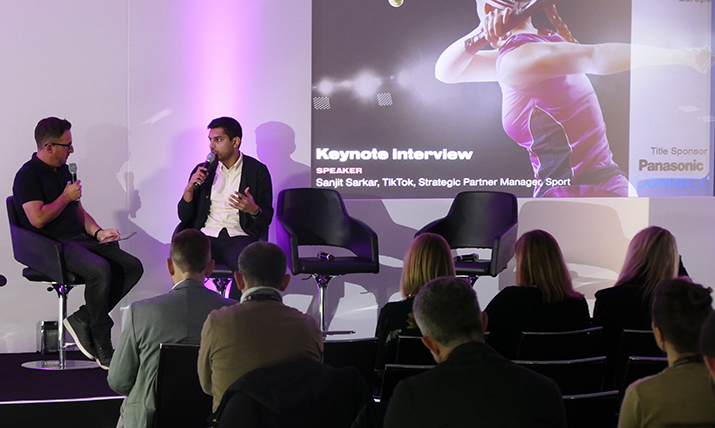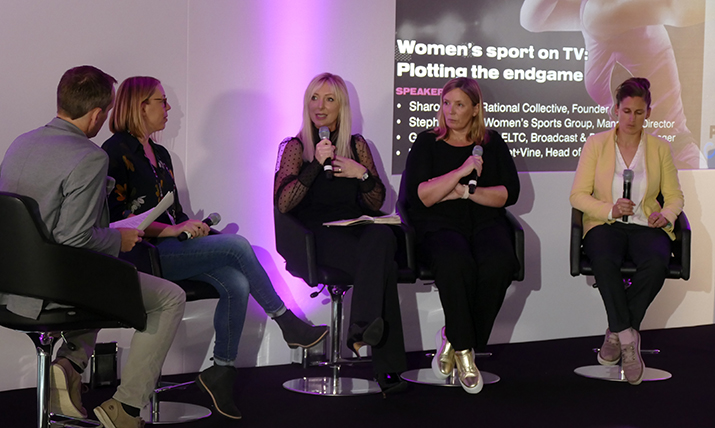FutureSPORT 2022: Metaverse, mobile and media connectivity top the agenda at SVG Europe London event

FutureSPORT, sponsored by Panasonic Connect, returned as an in-person event yesterday (15 November) with the great and the good of the sports broadcasting industry descending on Lord’s Cricket Ground in London for a packed day of networking, conference sessions and exhibits.
Over 250 people attended the event, which saw speakers from TikTok, Sky Sports, Premier League Productions and many more share their insights into how sports media will be produced, distributed and consumed in the coming months and years.
After networking, lunch and a tour of Lord’s, the conference began with the IABM’s head of knowledge, Lorenzo Zanni, setting the scene with a presentation outlining the changing face of sports media consumption and what it means for people working in production, broadcasting and technology provision and development.
“Football isn’t the best sport for 9:16. Golf would be a good sport for it but are there a lot of fans on TikTok looking for that content?”
He told the audience that the IABM had identified three key business and tech drivers in 2022 – convergence, transformation and resilience. Convergence, which he highlighted as the most forward-looking, is leading to greater investment in tech to enable interactivity and create new consumer experiences as well as more investment in data. Gaming is increasingly the epicentre of convergence in MediaTech, he said, bringing together broadcast, social, streaming and publishing.
Convergence can, however, be costly, particularly when it comes to latency. He cited the example of this year’s Super Bowl which saw high streaming numbers result in increased latency for providers.
Snappy highlights with TikTok
Next up, Sanjit Sarkar, strategic partner manager for sport at TikTok (pictured, top), spoke to SVG Europe editor Will Strauss about the platform’s relevance to sport and shared some content best practice tips.
“Live sport has a big part to play on TikTok – teams, leagues and rights holders find it a useful tool,” he said. While not in the business of acquiring rights, TikTok has strong relationships across the sports sector, working with organisations to develop audiences and engagement. Of course to do this, content is key.
“It doesn’t have to be sports content,” he explained. “It’s more about pre- and post-match, around the stadium and helping organisations to leverage their content to reach new fans.”
In terms of the best material to grow that audience, he shared: “Snappy, quick highlights never go out of fashion, but what works better is behind the scenes and first-person content, such as athlete-led material or even speaking to the team doctor or nutritionist – they all have a story to tell. It’s that unseen side that helps them develop a deeper relationship.”
Authentic mobile content
The issue of sports content for mobile was picked up by a panel featuring Robbie Spargo, director at Little Dot Sport, Mike Norrish, director of digital and creative, Premier League Productions, Scott Miles, Sky Sports, senior content operations manager, and Sharon Fuller, founder of Rational Collective.
Norrish agreed with Sarkar on the importance of unique, authentic content. “To take those raw, intimate personal stories from players and the atmosphere, it really complements that TV approach in a way that is really exciting and needed today.”
While Norrish was using the example of Premier League football, Spargo brought a different perspective through his work with electric offroad racing series Extreme E, which took a vertical first approach. “Using TikTok-native content creators is key,” he explained. “Extreme E travels to remote locations and TikTok was a great way to bridge the gap between viewers and those locations.”
With recorded content for mobile already being used to attract and engage audiences on a global scale, the conversation turned to what looks set to be the next step; live 9:16.
“There are parallels between robotics in factories or in medicine and robotic cameras. Sometimes there’s stuff that’s already there and we need to be better at adopting it.”
The consensus here seemed to be that its success depends on the sport and the audience – and it shouldn’t be done for the sake of it. Fuller gave the example of sports she’s worked with, including trampolining and freestyle football. “These are natural for 9:16,” she said. “Rather than go broadcast down, we’re going social up.”
Sky Sports’ Miles explained that while they didn’t shoot in 9:16, they did want to produce in 9:16. “That frame gives you a different take and lets you present content in a different way. But it’s about identifying the right content for the right platforms.”
Norrish added: “Football isn’t the best sport for 9:16. Golf would be a good sport for it but are there a lot of fans on TikTok looking for that content?”
With women’s sport drawing record viewing figures, the next session asked what more can be done to improve the way that it is shown and portrayed on TV and online.

Improving women’s sport
Fuller returned to the stage and was joined by Steph Harries, managing director, Women in Sport Group, Helena Sykes, head of content, Sunset+Vine, and Georgina Green, broadcast & production manager, AELTC (pictured, above).
The panel all agreed that having diversity throughout sports production and administration is crucial to improving how and when women’s sport is seen on TV and online.
Harries said: “The uplift in viewing figures is down to lots and lots of factors and it’s absolutely about the engagement through greater storytelling about athletes that perhaps the general public weren’t aware of before.”
Green agreed, adding: “It’s been the combination of a perfect storm for a lot of aspects of women’s sports,” However, parity is about more than viewing figures, she said: “It’s important to think not just about on screen but behind the scenes too. When you look at how many females are represented at the top level of sports administration, we’re still asked to be part of the conversation rather than actually leading the conversation; we’re still underrepresented when it comes to making the strategic decisions at that level.”
The panel also agreed that more diversity throughout sports could help to overcome the “group think at top level” and avoid the recent uproar created by New Zealand rugby bosses scheduling an All Blacks match at the same time as the Black Ferns were playing their World Cup quarter-final match.
Opportunities around 5G
Following a networking break, delegates returned to hear an in-depth discussion on The future of media connectivity, with a panel of telecoms firms and media companies coming together to discuss the opportunities around 5G and to try to solve some of the big contribution and distribution challenges.
Marco Dias Silva, 5G and edge computing expert at Vodafone Group, was quick to remind the audience that 5G is a suite of technologies. “It’s an enabler to create experiences,” he explained. This was picked up by Thomas Hainzel, head of digital industries evolution & partnerships, Nokia, who added: “It’s important to look at 5G as the technology enabler behind the experiences for the end customer. The customer will subscribe to those services if the technology is there.”
The potential to create new experiences is significant, whether for fans in stadiums, at home, or on the move. “There’s a whole contingent of different experiences you might want to create and all will have differing requirements but the options are there,” said Ian Wagdin, senior technology transfer manager at BBC R&D.
The panel also agreed that broadcasters and telcos have plenty to learn from each other. “There’s much to learn from a production, distribution and contribution point of view. It’s not going to happen today or tomorrow but we’re involved in the creation of a future,” said Dias Silva.
Wagdin took this even further. “We need to be less blinkered,” he said. “There are parallels between robotics in factories or in medicine and robotic cameras. Sometimes there’s stuff that’s already there and we need to be better at adopting it.”
Deep dive into the metaverse
The conference ended with a deep dive into the sporting metaverse with Lewis Wiltshire, CEO, Seven League, and Matt Stagg, director of mobile & immersive strategy, BT Sport/Warner Bros. Discovery.
With some in the industry believing the metaverse is over before it’s even really begun, the question of why rights holders and broadcasters should embrace it proved an interesting starting point. “Rights holders want more audiences and more money – at a business level,” said Wiltshire. “Web 3.0 offers this. NFTs can help with both; blockchain can solve problems around ticket touts; crypto will play some kind of role and the metaverse can bring people in in interesting ways.”
“It fills the gap between stadium and home,” added Stagg.
In terms of adoption timescales, Wiltshire explained: “Web 2.0 won’t just end, and the biggest wins of Web 3.0 won’t be apparent immediately. Web 3.0 is starting pretty much from now, but we won’t know the winners of that era until five years hence.”
Stagg reminded the audience that metaverse experiences don’t have to replace going to a live sporting event. “We forget that some people will never go to a Premier League match, so it’s not a replacement, that’s where we need to look.”
He also suggested in-stadium experiences that would add value to season ticket holders, such as being able to sample the view from a different seat, that could all drive engagement.
Wiltshire sounded a note of caution though: “There’s a sense people are rushing a bit. There has to be an objective. You can’t wait; you have to do tests and learn, but it has to be tied to your organisation.”
FutureSPORT 2022, sponsored by Panasonic Connect, took place on 15 November at Lord’s Cricket Ground in London.

